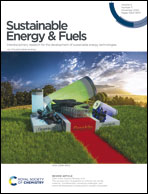Efficient conversion of cellulose to 5-hydroxymethylfurfural catalyzed by a cobalt-phosphonate catalyst†
Abstract
A heterogeneous cobalt-phosphonate network catalyst, [Co2(2,2′-bipy)(H4L)(H2O)]H2O (Co318), was synthesized by a hydrothermal reaction. The combination of Brønsted acid (–PO3H2) and Lewis acid (Co2+) sites makes Co318 an efficient catalyst for the conversion of saccharides to HMF. Under optimized conditions, glucose was quantitatively consumed and the yield of HMF was as high as 92%. Co318 was recycled four times without the loss of catalytic activity. When microcrystalline cellulose and regenerated cellulose were used, the yields of HMF were 33% and 50%, respectively, at 10 wt% catalyst loading. The yield of HMF increased to 59% when the loading of Co318 was increased to 40 wt%. GC-MS analysis confirmed that the reaction mixture contained both glucose and fructose intermediates, proving that the conversion of cellulose to HMF involved three steps: hydrolysis of cellulose to glucose, isomerization of glucose to fructose, and dehydration of fructose to HMF.



 Please wait while we load your content...
Please wait while we load your content...